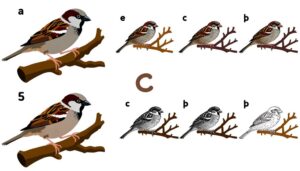How to Distinguish House Sparrows and Weaver Finches
House Sparrows (*Passer domesticus*) belong to the family Passeridae, whereas Weaver Finches are classified under Ploceidae. These avian families exhibit distinct evolutionary lineages, morphological traits, and ecological niches.
House Sparrows have conical bills for seed consumption and subdued plumage, while Weaver Finches often show vibrant hues and intricate nest-building behaviors. Nesting strategies also differ; sparrows use cavities, unlike the woven nests of Ploceidae.
Behavioral traits vary, with sparrows displaying adaptable foraging in urban environments and weavers showcasing territoriality. For a deeper understanding of these distinct avian families, explore their specific physical and behavioral adaptations in detail.

Key Takeaways
- House Sparrows belong to the family Passeridae, not Ploceidae.
- Weaver Finches are classified under the family Ploceidae.
- House Sparrows and Weaver Finches differ in evolutionary lineage and morphological traits.
- House Sparrows have conical bills, while many Weaver Finches have varied bill shapes.
- Nesting behavior differs; House Sparrows use cavities, whereas Weaver Finches build intricate nests.
Taxonomy and Classification
House Sparrows (Passer domesticus) belong to the family Passeridae, whereas Weaver Finches are classified under the family Ploceidae, highlighting a significant taxonomic distinction between the two groups.
Passeridae, encompassing true sparrows, is characterized by small, seed-eating birds with conical bills adapted for granivory. Conversely, Ploceidae includes species known for their intricate nest-building behaviors and social structures.
This taxonomic divergence is underscored by differences in their evolutionary lineage, morphological traits, and ecological niches.
The genus Passer, to which House Sparrows belong, is evolutionarily distinct from Ploceus, the genus comprising many Weaver Finches.
Understanding these taxonomic classifications aids ornithologists in studying avian biodiversity, behavior, and ecological roles, providing critical insights into the evolutionary pathways that differentiate these avian families.
Physical Characteristics
Distinctive physical characteristics differentiate *Passer domesticus* from members of the Ploceidae family, emphasizing their divergent evolutionary adaptations. House Sparrows exhibit unique morphological attributes that set them apart:
- Plumage: House Sparrows possess a more subdued coloration, typically brown and grey, whereas many Ploceidae exhibit vibrant hues and intricate patterns.
- Bill Shape: The conical bill of *Passer domesticus* is adapted for seed consumption, contrasting with the often more varied bill shapes in Ploceidae, suited for diverse diets.
- Size: House Sparrows are generally smaller, with an average length of 16 cm, while many weaver finches can be notably larger.
- Sexual Dimorphism: In *Passer domesticus*, males and females display distinct plumage differences, which is less pronounced in some Ploceidae species.
Behavioral Traits
*Passer domesticus* exhibits a range of behavioral traits that are distinct from those observed in the Ploceidae family, highlighting their differing ecological niches and social structures.
House Sparrows demonstrate a highly adaptable foraging strategy, often exploiting urban environments to access food resources. They exhibit gregarious behavior, forming flocks outside the breeding season, which enhances their ability to locate food and evade predators.
In contrast, many Ploceidae species, such as those in the genus *Ploceus*, display more specialized foraging techniques and exhibit pronounced territoriality. Social interactions within *Passer domesticus* are characterized by frequent vocalizations and complex hierarchies, whereas Ploceidae species often engage in elaborate display behaviors to establish dominance and attract mates, reflecting their more intricate social dynamics.
Nesting and Breeding
In addition to their behavioral adaptations, *Passer domesticus* displays unique nesting and breeding strategies that further distinguish them from the Ploceidae family.
These strategies are characterized by:
- Nesting Sites: House sparrows typically choose cavities in buildings or natural crevices, unlike the elaborate woven nests of the Ploceidae.
- Nest Construction: Their nests are composed of coarse materials such as straw and twigs, lined with feathers and soft grasses, contrasting the intricate weaving of weaver finches.
- Breeding Season: They exhibit a prolonged breeding season, often producing multiple broods per year, a trait less common in many Ploceidae species.
- Parental Care: Both male and female sparrows share responsibilities in feeding and protecting the young, showcasing a collaborative effort uncommon in many finch species.
These distinctions underscore the taxonomic and ecological divergence between *Passer domesticus* and Ploceidae.
Habitat and Distribution
House sparrows (*Passer domesticus*) exhibit a remarkable adaptability, occupying a wide range of habitats from urban centers to rural farmlands across nearly every continent. Their distribution spans North America, Europe, Asia, and parts of Africa and Australia, showcasing their eurytopic nature.
Urban environments provide abundant food sources and nesting sites, while agricultural landscapes offer grains and seeds. Adaptations such as granivorous feeding habits and social nesting behaviors contribute to their widespread success. Primarily associated with human settlements, these birds often form symbiotic relationships with human activities.
Ecological studies indicate their preference for temperate climates, although they can endure arid and tropical conditions. Their extensive range and habitat versatility underscore their robust ecological plasticity and resilience.
Conclusion
House sparrows (Passer domesticus) are indeed classified within the family Passeridae, aligning them with weaver finches. Significantly, they exhibit distinct physical and behavioral traits, such as their robust beaks and social nesting habits.
An intriguing statistic highlights their adaptability: house sparrows have expanded their range to nearly every continent, becoming one of the most widespread birds globally. This extensive distribution underscores their remarkable ecological versatility and resilience, positioning them as a significant subject of ornithological study.






